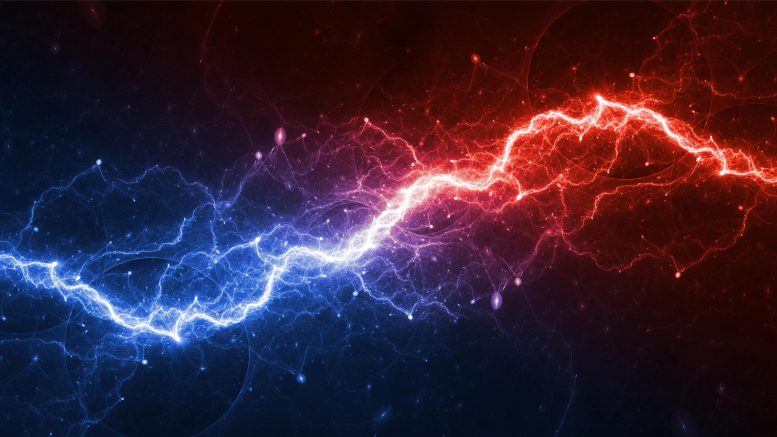
Researchers discovered that the electronic properties of the new iron-based high-temperature superconductor (HTS) vary horizontally and vertically.
A new study from a team of physicists offers new clues to scientists studying the mystery of high-temperature superconductivity, finding that electronic properties of a new iron-based high-temperature superconductor were different in the horizontal and vertical directions.
Physicists from Rice University, Kyoto University and the Japan Synchrotron Radiation Research Institute (JASRI) are offering new details this week in the journal Nature regarding intriguing similarities between the quirky electronic properties of a new iron-based high-temperature superconductor (HTS) and its copper-based cousins.
While investigating a recently discovered iron-based HTS, the researchers found that its electronic properties were different in the horizontal and vertical directions. This electronic asymmetry was measured across a wide range of temperatures, including those where the material is a superconductor. The asymmetry was also found in materials that were “doped” differently. Doping is a process of chemical substitution that allows both copper- and iron-based HTS materials to become superconductors.
“The robustness of the reported asymmetric order across a wide range of chemical substitutions and temperatures is an indication that this asymmetry is an example of collective electronic behavior caused by quantum correlation between electrons,” said study co-author Andriy Nevidomskyy, assistant professor of physics at Rice.
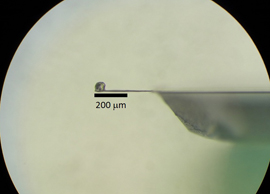
This image shows a microscopic sample of a high-temperature superconductor glued to the tip of a cantilever. To study the magnetic properties of the sample, scientists applied a magnetic field and measured the torque that was transferred from the sample to the cantilever. Credit: Shigeru Kasahara/Kyoto University
The study by Nevidomskyy and colleagues offers new clues to scientists studying the mystery of high-temperature superconductivity, one of physics’ greatest unsolved mysteries.
Superconductivity occurs when electrons form a quantum state that allows them to flow freely through a material without electrical resistance. The phenomenon only occurs at extremely cold temperatures, but two families of layered metal compounds — one based on copper and the other on iron — perform this mind-bending feat just short of or above the temperature of liquid nitrogen — negative 321 degrees Fahrenheit(-196 degrees Celsius) — an important threshold for industrial applications. Despite more than 25 years of research, scientists are still debating what causes high-temperature superconductivity.
Copper-based HTSs were discovered more than 20 years before their iron-based cousins. Both materials are layered, but they are strikingly different in other ways. For example, the undoped parent compounds of copper HTSs are nonmetallic, while their iron-based counterparts are metals. Due to these and other differences, the behavior of the two classes of HTSs are as dissimilar as they are similar — a fact that has complicated the search for answers about how high-temperature superconductivity arises.
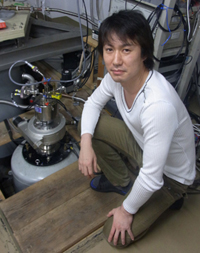
Shigeru Kasahara, the study’s first author, with the cryogenic apparatus used in the experiments. Credit: Shigeru Kasahara/Kyoto University
One feature that has been found in both compounds is electronic asymmetry — properties like resistance and conductivity are different when measured up and down rather than side to side. This asymmetry, which physicists also call “nematicity,” has previously been found in both copper-based and iron-based high-temperature superconductors, and the new study provides the strongest evidence yet of electronic nematicity in HTSs.
In the study, the researchers used the parent compound barium iron arsenide, which can become a superconductor when doped with phosphorus. The temperature at which the material becomes superconducting depends upon how much phosphorus is used. By varying the amount of phosphorus and measuring electronic behavior across a range of temperatures, physicists can probe the causes of high-temperature superconductivity.
Prior studies have shown that as HTS materials are cooled, they pass through a series of intermediate electronic phases before they reach the superconducting phase. To help see these “phase changes” at a glance, physicists like Nevidomskyy often use graphs called “phase diagrams” that show the particular phase an HTS will occupy based on its temperature and chemical doping.
“With this new evidence, it is clear that the nematicity exists all the way into the superconducting region and not just in the vicinity of the magnetic phase, as it had been previously understood,” said Nevidomskyy, in reference to the line representing the boundary of the nematic order. “Perhaps the biggest discovery of this study is that this line extends all the way to the superconducting phase.”
He said another intriguing result is that the phase diagram for the barium iron arsenide bears a striking resemblance to the phase diagram for copper-based high-temperature superconductors. In particular, the newly mapped region for nematic order in the iron-based material is a close match for a region dubbed the “pseudogap” in copper-based HTSs.
“Physicists have long debated the origins and importance of the pseudogap as a possible precursor of high-temperature superconductivity,” Nevidomskyy said. “The new results offer the first hint of a potential analog for the pseudogap in an iron-based high-temperature superconductor.”
The nematic order in the barium iron arsenide was revealed during a set of experiments at Kyoto University that measured the rotational torque of HTS samples in a strong magnetic field. These findings were further corroborated by the results of X-ray diffraction performed at JASRI and aided by Nevidomskyy’s theoretical analysis. Nevidomskyy and his collaborators believe that their results could help physicists determine whether electronic nematicity is essential for HTS.
Nevidomskyy said he expects similar experiments to be conducted on other varieties of iron-based HTS. He said additional experiments are also needed to determine whether the nematic order arises from correlated electron behavior.
Nevidomskyy, a theoretical physicist, specializes in the study of correlated electron effects, which occur when electrons lose their individuality and behave collectively.
“One way of thinking about this is to envision a crowded stadium of football fans who stand up in unison to create a traveling ‘wave,’” he said. “If you observe just one person, you don’t see ‘the wave.’ You only see the wave if you look at the entire stadium, and that is a good analogy for the phenomena we observe in correlated electron systems.”
Nevidomskyy joined the research team on the new study after meeting the lead investigator, Yuji Matsuda, at the Center for Physics in Aspen, Colo., in 2011. Nevidomskyy said Matsuda’s data offers intriguing hints about a possible connection between nematicity and high-temperature superconductivity.
“It could just be serendipity that nematicity happens in both the superconducting and the nonsuperconducting states of these materials,” Nevidomskyy said. “On the other hand, it could be that superconductivity is like a ship riding on a wave, and that wave is created by electrons in the nematic collective state.”
Reference: “Electronic nematicity above the structural and superconducting transition in BaFe2(As1−xP x )2” by S. Kasahara, H. J. Shi, K. Hashimoto, S. Tonegawa, Y. Mizukami, T. Shibauchi, K. Sugimoto, T. Fukuda, T. Terashima, Andriy H. Nevidomskyy and Y. Matsuda, 20 June 2012, Nature.
DOI: 10.1038/nature11178
Study co-authors include S. Kasahara, H.J. Shi, K. Hashimoto, S. Tonegawa, Y. Mizukami, T. Shibauchi and T. Terashima, all of Kyoto University; K. Sugimoto of JASRI; T. Fukuda of the Japan Atomic Energy Agency. The research was funded by the Japanese Society for the Promotion of Science, the Japanese Ministry of Education, Culture, Sports, Science and Technology, and the collaboration was made possible by the Aspen Center for Physics.

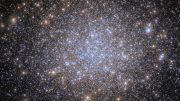



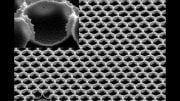
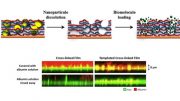
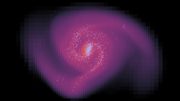

Real physics here